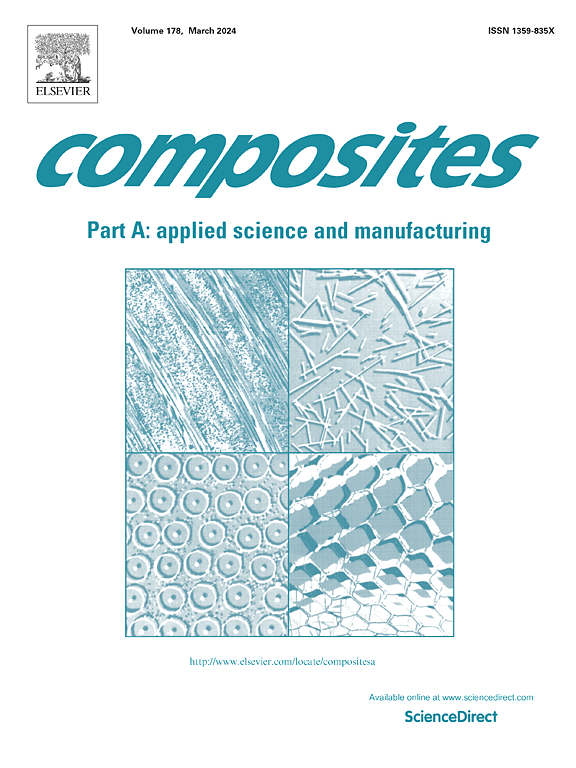Ni过渡层对SiCp/Fe-Cu夹层结构的影响:促进界面结合,协同提高强度和延展性
IF 8.1
2区 材料科学
Q1 ENGINEERING, MANUFACTURING
Composites Part A: Applied Science and Manufacturing
Pub Date : 2025-05-09
DOI:10.1016/j.compositesa.2025.109020
引用次数: 0
摘要
为了获得综合性能优异的材料,采用火花等离子烧结法制备了SiCp增强铁铜(SiCp/Fe-Cu)夹层结构复合材料。在夹层结构中加入Ni过渡层以增强界面结合。结果表明,Ni过渡层与Fe层形成非晶界面产物,界面结合更加紧密。Cu层的引入显著提高了材料的导热系数,烧结后的SiCp/Fe-Cu夹层结构的导热系数达到SiCp/Fe的211.20%,SiCp/Fe- ni -Cu夹层结构的导热系数达到SiCp/Fe的232.32%。Ni过渡层使SiCp/Fe-Ni-Cu结构具有优异的延展性,比SiCp/Fe-Cu结构高出180%。两种夹层结构均存在非协调塑性变形现象;Cu层呈现贯通裂纹,而SiCp/Fe层呈现局部裂纹。夹层结构中各层的破坏机制不同,Cu层为剪切断裂,SiCp/Fe层为拉伸断裂。本文章由计算机程序翻译,如有差异,请以英文原文为准。
Influence of the Ni transition layer on the SiCp/Fe-Cu sandwich structure: Promoting interfacial bonding and synergistically enhancing strength and ductility
To obtain the material with excellent comprehensive properties, SiCp-reinforced iron-copper (SiCp/Fe-Cu) sandwich-structured composites were fabricated by spark plasma sintering. A Ni transition layer was added into the sandwich structure to enhance interfacial bonding. The results indicated that the Ni transition layer formed an amorphous interfacial product with Fe layer, resulting in tighter interfacial bonding. The introduced Cu layer significantly improved material’s thermal conductivity, with the sintered SiCp/Fe-Cu sandwich structure achieving 211.20% of the thermal conductivity of SiCp/Fe, and the SiCp/Fe-Ni-Cu sandwich structure reaching 232.32% of SiCp/Fe. The Ni transition layer brought the SiCp/Fe-Ni-Cu structure exceptional ductility, surpassing the SiCp/Fe-Cu structure by 180%. In both sandwich structures, phenomena of non-coordinated plastic deformation were observed; while the Cu layer exhibited through-cracks, the SiCp/Fe layer experienced local cracking. Each layer in the sandwich structures displayed different failure mechanisms: the Cu layer underwent shear fracture, while the SiCp/Fe layer experienced tensile fracture.
求助全文
通过发布文献求助,成功后即可免费获取论文全文。
去求助
来源期刊

Composites Part A: Applied Science and Manufacturing
工程技术-材料科学:复合
CiteScore
15.20
自引率
5.70%
发文量
492
审稿时长
30 days
期刊介绍:
Composites Part A: Applied Science and Manufacturing is a comprehensive journal that publishes original research papers, review articles, case studies, short communications, and letters covering various aspects of composite materials science and technology. This includes fibrous and particulate reinforcements in polymeric, metallic, and ceramic matrices, as well as 'natural' composites like wood and biological materials. The journal addresses topics such as properties, design, and manufacture of reinforcing fibers and particles, novel architectures and concepts, multifunctional composites, advancements in fabrication and processing, manufacturing science, process modeling, experimental mechanics, microstructural characterization, interfaces, prediction and measurement of mechanical, physical, and chemical behavior, and performance in service. Additionally, articles on economic and commercial aspects, design, and case studies are welcomed. All submissions undergo rigorous peer review to ensure they contribute significantly and innovatively, maintaining high standards for content and presentation. The editorial team aims to expedite the review process for prompt publication.
 求助内容:
求助内容: 应助结果提醒方式:
应助结果提醒方式:


